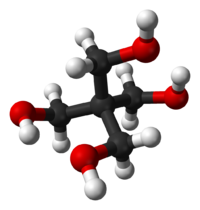- Pentaerythritol
-
Pentaerythritol 
 2,2-Bis(hydroxymethyl)1,3-propanediolOther namesHercules P 6, monopentaerythritol, tetramethylolmethane, THME, PETP, pentaerythrite, Pentek, Hercules Aqualon improved technical PE-200
2,2-Bis(hydroxymethyl)1,3-propanediolOther namesHercules P 6, monopentaerythritol, tetramethylolmethane, THME, PETP, pentaerythrite, Pentek, Hercules Aqualon improved technical PE-200Identifiers CAS number 115-77-5 
UNII SU420W1S6N 
Properties Molecular formula C5H12O4 Molar mass 136.15 Appearance white solid Density 1.396g/cm3 Melting point 260.5 °C
Boiling point 276 °C at 30 mmHg
Solubility in water 5.6 g/100 mL at 15°C Hazards Flash point 200.1°C  (verify) (what is:
(verify) (what is:  /
/ ?)
?)
Except where noted otherwise, data are given for materials in their standard state (at 25 °C, 100 kPa)Infobox references Pentaerythritol is the organic compound with the formula C5H12O4. This white, crystalline polyol with the neopentane backbone is a versatile building block for the preparation of many polyfunctionalized compounds such as the explosive PETN and pentaerythritol tetraacrylate.[1] Derivatives of pentaerythritol are components of alkyd resins, varnishes, PVC stabilizers, tall oil esters, and olefin antioxidants.
Halogen-free pentaerythritol esters are also environmentally friendly alternative to conventional electrical transformer fluids, being both readily biodegradable and non-hazardous in water. They advantageously replace polychlorobiphenyl (PCB), and even silicone-based or fluorinated hydrocarbons, as dielectric fluid in transformers. Their low volatility and high flash point give them an excellent resistance to ignition in case of major electrical failure and transformer rupture.
Synthesis
Pentaerythritol can be prepared by condensation of acetaldehyde and formaldehyde in a basic environment (Tollens' reaction).[2] The process occurs by successive aldol reactions followed by a Cannizzaro reaction. Impurities include dipentaerythritol and tripentaerythritol.[3]
- 2 CH3CHO + 8 CH2O + Ca(OH)2 → 2 C(CH2OH)4 + (HCOO)2Ca
References
- ^ S. F. Marrian (1948). "The Chemical Reactions of Pentaerythritol and its Derivatives". Chemical Reviews 43 (1): 149–202. doi:10.1021/cr60134a004. PMID 18876970.
- ^ H. B. J. Schurink (1941), "Pentaerythritol", Org. Synth., http://www.orgsyn.org/orgsyn/orgsyn/prepContent.asp?prep=CV1P0425; Coll. Vol. 1: 425
- ^ M. S. Peters, J. A. Quinn (1955). "Pentaerythritol Production Yields". Industrial & Engineering Chemistry 47 (9): 1710–1713. doi:10.1021/ie50549a016.
Categories:- Polyols
Wikimedia Foundation. 2010.
